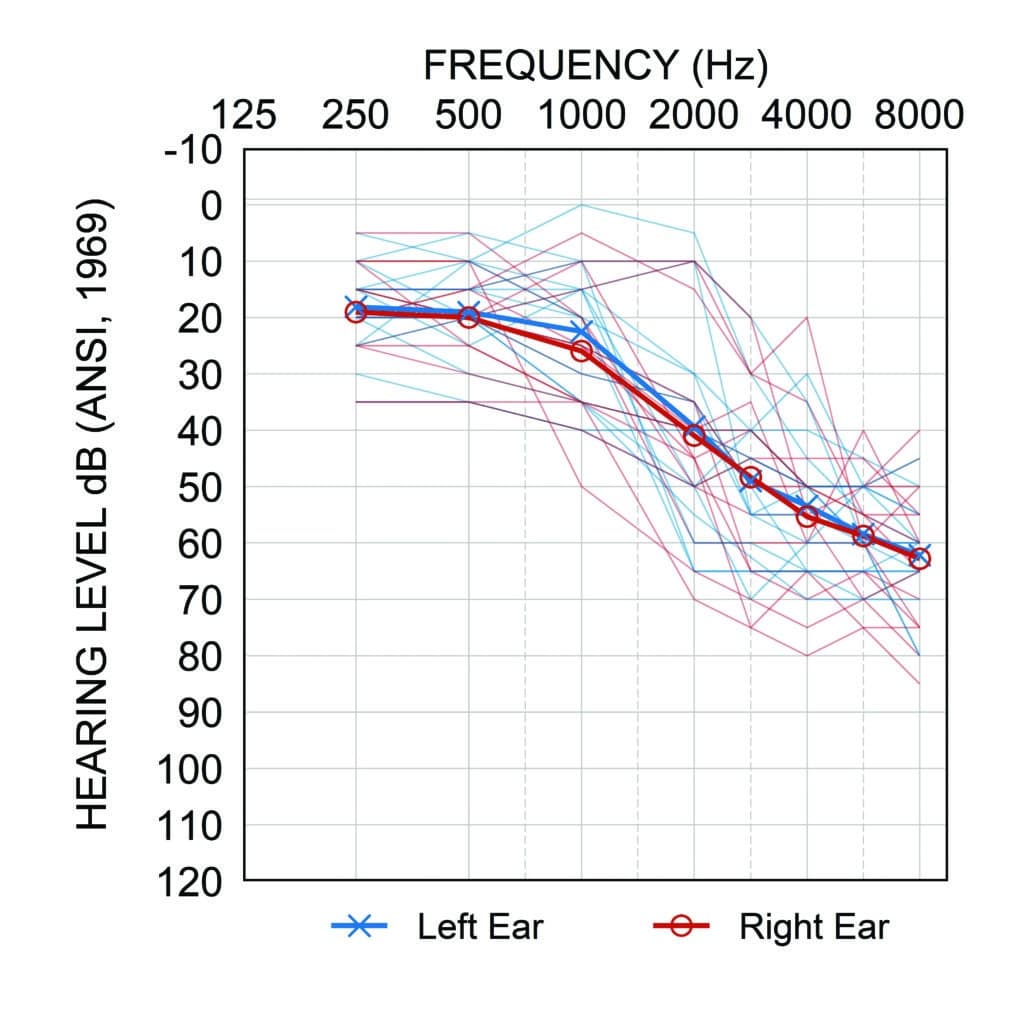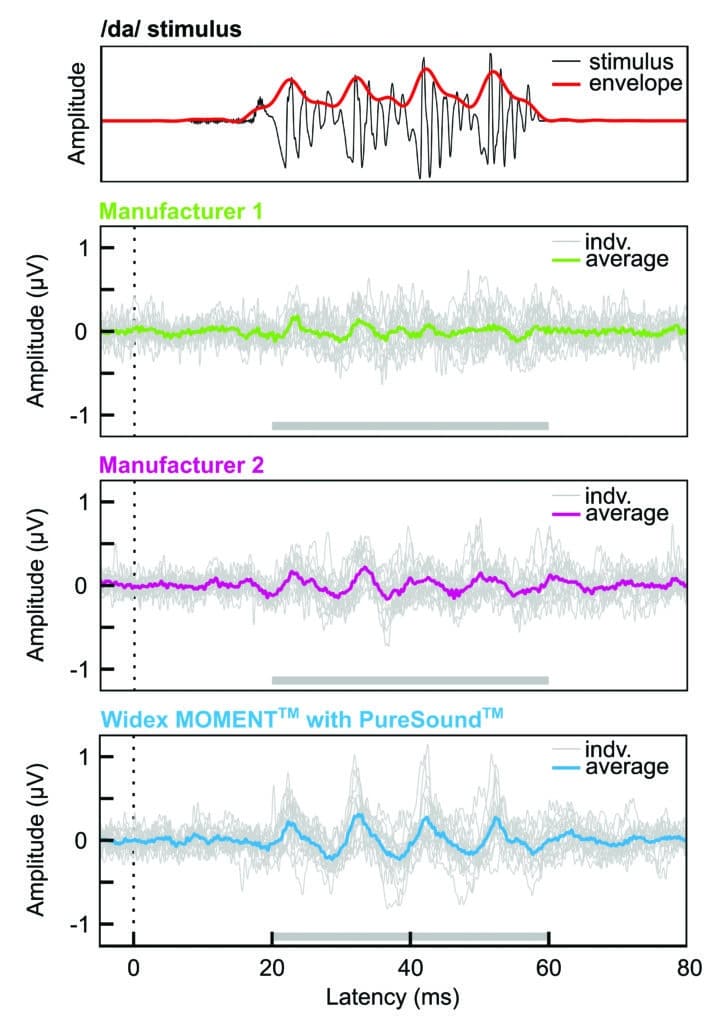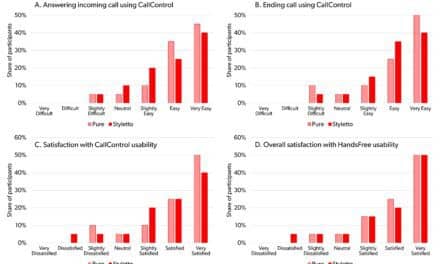Tech Topic | August 2020 Hearing Review
By Christopher Slugocki, PhD; Francis Kuk, PhD; Petri Korhonen, MSc; and Neal Ruperto, AuD
Research suggests that listeners rely on stimulus envelope cues for robust speech comprehension in both quiet and noisy conditions. This study compares three premium hearing aids, including Widex MOMENT hearing aids with ZeroDelay™ technology, relative to how they might affect the central auditory system’s ability to encode the temporal envelope of the input sounds—and therefore possibly distort the quality of the temporal envelope code available for higher-level auditory processing.
Widex has always designed hearing aids to provide wearers with the most natural sound. This involves ensuring undistorted input even at high levels,1providing sufficient amplification over an extended frequency range,2 and preserving sound’s natural temporal characteristics with the use of slow-acting compression.3 The PureSound™ feature on the recently introduced MOMENT™ hearing aid leverages ZeroDelay™ technology to further preserve the integrity of the input sounds in vented (especially open) fittings. This is achieved by shortening the processing delay of the hearing aid to less than 0.5 ms across frequencies.
The ultra-low delay of PureSound promotes synchrony between the amplified sound from the hearing aid receiver and the direct (unamplified) sound reaching the ear canal via the vent. The result is a signal virtually free of comb-filtering effects4 that would otherwise impart “metallic” or “hollow” qualities onto sound.5 Indeed, our studies have shown that PureSound processing enhances sound quality and own-voice perception in open-fit wearers4 without sacrificing speech intelligibility at realistic SNRs.6
Achieving better synchrony between amplified and direct signals also preserves sound’s natural envelope. This is important as studies suggest that listeners rely on envelope cues for robust speech comprehension in both quiet and noisy conditions.7 In the brain, envelope information is represented by a “rate code” where populations of neurons “phase-lock” to periodic modulations of the sound envelope. This rate code, which originates in the auditory nerve, is carried up the auditory pathway where it is acted on and transformed by more complex auditory processes. The phase-locked activity of auditory neurons can be recorded from listeners using electroencephalography (EEG). Such EEG signals are broadly referred to as frequency-following responses (FFRs; for a review, see Skoe and Kraus8) or envelope-following responses (EFRs) when the interest is on neural activity entrained to the temporal envelope.9
Commonly, EFR experiments measure how well auditory neurons encode the fundamental frequency (f0) of speech sounds (eg, vowels). As the harmonics of a vowel are all amplitude modulated by the glottal rate (f0), using synthetic speech offers a window into how well the amplitude envelope is tracked across frequencies. The literature suggests that more robust EFRs are associated with better speech-in-noise abilities10 and group-level differences in auditory processing abilities as marked by musicianship11or tonal language experience.12 Conversely, speech-evoked EFRs have been shown to degrade in the presence of background noise.13
In this study, we examine how ZeroDelay technology affects the central auditory system’s ability to encode the temporal envelope of the input sounds. This would provide important information regarding how hearing aid delay might distort the quality of the temporal envelope code available for higher level auditory processing.
We speculate that the interaction between the direct sound and the amplified sound in an open-fitting will create patterns of interference that distort the temporal envelope (ie, f0) of the synthetic /da/ syllable in the EFR. Moreover, the temporal envelope distortion should be greater for open-fit hearing aids with longer processing delays. Thus, we compared EFRs measured with the Widex PureSound program against premium hearing aids from two leading manufacturers with longer delay times.4 We expect that the hearing aids with longer delays will yield less robust EFRs compared to the PureSound program.
Study Method
Participants. A total of 16 older hearing-impaired listeners participated in the study. Subjects ranged in age from 58 to 81 years with a mean age of 69.8 years. Ten listeners were current hearing aid wearers with experience ranging from 1 to 15 years. One listener participated in hearing aid studies previously, but was not a wearer at the time of study, and 5 had never worn hearing aids. Subjects had a bilaterally symmetrical (within 10 dB) mild-to-moderate sensorineural hearing loss (Figure 1). All subjects passed cognitive screening using the Montreal Cognitive Assessment (MoCA average score = 26.2). The protocol was approved by an external institutional review board and informed consent was obtained from all participants.

Hearing aids. The PureSound program on the Widex MOMENT hearing aid was compared to premium products from two other manufacturers’ fit to the NAL-NL2 gain target with default feature settings. All devices were coupled using open instant-fit ear-tips. All three hearing aids had top-of-the-line processing features expected of premium products, such as adaptive directional microphones, noise reduction, and feedback management, with the exception that the PureSound program uses an omnidirectional microphone. Acoustic measurements indicated a broadband delay of 0.5 ms for the PureSound program, and delays of 6 ms and 8 ms for Manufacturer 1 and Manufacturer 2, respectively.
Electroencephalography. Testing took place in a sound isolated booth. A Klatt synthesized /da/ syllable (duration = 50 ms) was presented at 70 dB SPL in alternating polarities over 8000 trials (4000 per polarity). Stimuli were presented in free-field through a powered loudspeaker positioned at 1 m directly in front of the listeners. Listener EEG was recorded using a vertical montage, with an active vertex (Cz) electrode referenced against linked earlobes with high forehead as ground. Impedance at electrode sites was maintained below 35 kΩs. Electrode activity was captured using a g.tec g.USBamp (Guger Technologies, GmbH) bio-signal amplifier at a sampling rate of 19.2 kHz.
Analysis. Continuous EEG data were first filtered between 80 Hz and 2000 Hz and then epoched (cut) from -10 to 80 ms relative to stimulus onset. Epochs were rejected if they contained activity exceeding ±35 μV. Around 7400 trials (3700 per polarity) survived artifact rejection and were then averaged in the time domain for each combination of listener and condition.
Results
Figure 2 compares the time-domain EFRs measured in each hearing aid condition against the synthetic /da/ syllable. The temporal amplitude envelope of the /da/ syllable is shown by the red line in the upper panel. We can see that average EFRs (shown by the bolded colored lines in the lower panels) most closely resembled the envelope of the /da/ stimulus when listeners wore the Widex MOMENT hearing aid with PureSound. Conversely, EFRs were distorted when listeners wore premium hearing aids from the other two manufacturers.

The advantage of PureSound processing is also visible in the time-frequency domain as shown in Figure 3. Here, averaged time-domain data were decomposed through continuous wavelet transforms using analytic (complex) Morse wavelets. The resulting figures plot the power of EFRs at each frequency over the duration of the /da/ stimulus. Brighter colors reflect more robust encoding of the temporal envelope. Comparing the three hearing aids shows that the PureSound condition has the most “yellow” and “light blue” concentrated around 100 Hz. This suggests that PureSound maintained the greatest sustained energy corresponding to the f0of the /da/ syllable, followed by Manufacturer 2 and then Manufacturer 1.

The average amplitude spectra of EFRs from each hearing aid condition are shown in Figure 4. Here we see that the EFR spectral peak corresponding to the /da/ envelope (i.e., f0 = 100 Hz) was the highest for the PureSound followed by Manufacturer 2 and Manufacturer 1. A repeated measures ANOVA confirmed that peak f0energy was significantly affected by hearing aid condition (F(1.20,18.06) = 6.48, p = 0.016, η2 = 0.18). Post-hoc paired-samples t-tests (two-tailed, α = 0.05) indicated that EFRs were indeed more robust when listeners wore the Widex MOMENT hearing aids with PureSound compared to the premium devices from Manufacturers 1 and 2. In addition, EFRs were stronger for Manufacturer 2 compared to Manufacturer 1.

Together, these results suggest that the longer hearing aid delays found on some premium hearing aids distort neural tracking of a sound’s temporal envelope when these devices are fit with an open ear-tip.
Discussion
In open-fittings, we found that ZeroDelay technology featured in the PureSound program of the Widex MOMENT hearing aid promoted robust neural tracking of the speech envelope. Conversely, premium current generation devices from two other manufacturers, which featured longer processing delays, were found to greatly distort neural envelope tracking. This finding builds on the sound quality preferences for PureSound processing presented by Balling et al4 and suggests a need to reconsider the acceptable criteria for tolerable hearing aid delay in open-fittings (eg, see Stone et al, 200814).
The long-term effects of distorted temporal envelope encoding, especially in more difficult listening conditions, are presently unknown. According to the Framework for Understanding Effortful Listening (FUEL) proposed by Pichora-Fuller et al,15 successful speech comprehension may require greater cognitive energy (ie, effort) when the quality of the signal available to the listener is suboptimal. The fundamental frequency of a target talker is thought to provide an important cue for extracting the target voice from competing irrelevant auditory information, such as other talkers16 or environmental noises. Specifically, f0envelopes likely facilitate processes related to auditory scene analysis17by biding speech energy across frequencies and over time to aid in vocal pitch perception18and speaker identification.19 Neural encoding of f0(ie, the EFR), at least in normal-hearing listeners, does appear to faithfully reflect pitch perception20and predict speech-in-noise abilities.10 If such cues are continually distorted, then everyday listening activities may demand more effort than listeners are able or willing to expend. Over time, this can lead to chronic stress, fatigue, and social withdrawal, all of which have negative effects on cognition and quality of life.21
Swaminathan and Heinz7posit that the speech-in-noise deficits in listeners with sensorineural hearing loss (SNHL) may partly reflect the loss of temporal envelope information that would normally be recovered from the temporal fine structure. This is similar to how the EFR represents encoding of amplitude modulation recovered across the harmonics of the speech signal. Indeed, such issues would be expected to follow SNHL due to the well-documented broadening of cochlear tuning.22 However, both perceptual and neurophysiological studies suggest that neural encoding of the temporal speech envelope is not degraded following SNHL, at least in quiet conditions.23,24Attempts to resolve these findings have proposed some form of compensatory plasticity at the level of brainstem or midbrain that acts to restore envelope encoding in quiet, but breaks down in complex listening conditions or with degraded envelope cues (for a review, see Parthasarathy et al, 2019 25). If true, this provides promise for hearing aid strategies that promote neural envelope tracking by better preserving the input envelope via technologies such as slower compression speeds and, as demonstrated here, ultra-low processing delays in open-fittings.
We should also consider that the effect reported in this study may partly underlie listeners’ strong preferences for the PureSound program based on sound quality and own-voice judgements.4 These are important observations that may help ensure a smooth transition to aided auditory perception and better device adoption/satisfaction for first-time users. Indeed, clinical trends towards issuing instant open-fit ear tips speak to the need for establishing an ease and naturalness to the hearing aid experience right from the moment of first fit. Promoting early hearing aid adoption in listeners with mild-to-moderate hearing loss is an ongoing struggle for hearing healthcare professionals. Many listeners perceive a limited handicap, and so device occlusion and comfort often outweigh the benefit of improved audibility.26 Open-fittings have been shown to provide wearers with a greater sense of device transparency, reduced occlusion effects, and greater device satisfaction.27 ZeroDelay technology adds to that advantage and makes first-fit even more transparent.
We now have multiple lines of evidence to suggest that the ZeroDelay technology behind PureSound processing further enhances the transparency of open-fit hearing aids by removing spectral and temporal distortions associated with hearing aid delay. While this study was conducted with open-fitting, the observations likely apply to other vented fittings, because comb-filtering can occur in any fittings that allow for acoustic leakage. This means that ZeroDelay technology could potentially benefit a majority of hearing aid wearers—and not just those with a mild hearing loss. Together, these qualities may promote device adoption and satisfaction as we help our patients return to the world of natural sounds.
References
1. Oeding K, Valente M. The effect of a high upper input limiting level on word recognition in noise, sound quality preferences, and subjective ratings of real-world performance. J Am Acad Audiol.2015;26(6):547-562.
2. Peeters H, Lau C, Kuk F. Speech-in-noise potential of hearing aids with extended bandwidth. Hearing Review. 2011;18(3):28–36.
3. Kuk F. Rationale and requirements for a slow acting compression hearing aid. Hear Jour. 1998;51(6):45–79.
4. Balling LW, Townend O, Stiefenhofer G, Switalski W. Reduced hearing aid delay for optimal sound quality: A new paradigm in processing. Hearing Review.2020;27(4):20-26.
5. Bramslow L. Preferred signal path delay and high-pass cut-off in open fittings. Int J Audiol.2010;49(9):634-644.
6. Kuk F, Ruperto N, Slugocki C, Korhonen P. Efficacy of directional microphones in open-fitting under realistic signal-to-noise ratios. Hearing Review.2020;27(6):20-23.
7. Swaminathan J, Heinz MG. Psychophysiological analyses demonstrate the importance of neural envelope coding for speech perception in noise. J Neurosci. 2012;32(5):1747-1756.
8. Skoe E, Kraus N. Auditory brainstem response to complex sounds: A tutorial. Ear Hear. 2010;31(3):302-324.
9. Aiken SJ, Picton TW. Envelope and spectral frequency-following responses to vowel sounds. Hear Res. 2008;245(1-2):35-47.
10. Song JH, Skoe E, Banai,K, Kraus N. Perception of speech in noise: Neural correlates. J Cogn Neurosci.2011;23(9):2268-2279.
11. Musacchia G, Strait D, Kraus N. Relationships between behavior, brainstem and cortical encoding of seen and heard speech in musicians and non-musicians. Hear Res. 2008;241(1-2):34-42.
12. Krishnan A, Xu Y, Gandour J, Cariani P. Encoding of pitch in the human brainstem is sensitive to language experience. Cogn Brain Res. 2005;25(1):161-168.
13. Li X, Jeng F-C. Noise tolerance in human frequency-following responses to voice pitch. J Acoust Soc Am. 2011;129(1):EL21.
14. Stone MA, Moore BCJ, Meisenbacher K, Derleth RP. Tolerable hearing aid delays. V. Estimation of limits for open canal fittings. Ear Hear.2008;29(4):601-617.
15. Pichora-Fuller MK, Kramer SE, Eckert MA, et al. Hearing impairment and cognitive energy: The framework for understanding effortful listening (FUEL). Ear Hear.2016;37:5S-27S.
16. Summers V, Leek MR. F0 processing and the separation of competing speech signals by listeners with normal hearing and with hearing loss. J Speech Lang Hear Res.1998;41(6):1294-1306.
17. Bregman AS. Auditory scene analysis: The perceptual organization of sound. Bradford Books, MIT Press;1990.
18. Oxenham AJ. Pitch perception. J Neurosci.2012;32(39):13335-13338.
19. Baumann O, Belin P. Perceptual scaling of voice identity: Common dimensions for different vowels and speakers. Psychol Res. 2010;74(110).
20. Coffey EBJ, Colagrosso EMG, Lehmann A, Schöwnwiesner M, Zatorre RJ. Individual differences in the frequency-following response: Relation to pitch perception. PLoS ONE.2016:1-27.
21. Pichora-Fuller M, Mick PT, Reed M. Hearing, cognition, and healthy aging: Social and public health implications of the links between age-related declines in hearing and cognition. Semin Hear. 2015;36(3):122-139.
22. Liberman MC, Dodds LW. Single-neuron labeling and chronic cochlear pathology. III. Stereocilia damange and alterations of threshold tuning curves. Hear Res.1984;16(1):55-74.
23. Lorenzi C, Gilbert G, Carn H, Garnier S, Moore BCJ. Speech perception problems of the hearing impaired reflect inability to use temporal fine structure. Proc Natl Acad Sci USA. 2006;103(49):18866-18869.
24. Kale S, Heinz MG. Envelope coding in auditory nerve fibers following noise-induced hearing loss. J Assoc Res Otolaryngol.2010;11:657-673.
25. Parthasarathy A, Bartlett EL, Kujawa SG. Age-related changes in neural coding of envelope cues: Peripheral declines and central compensation. Neurosci.2019;407(21):21-31.
26. Kochkin S. MarkeTrak VIII: The key influencing factors in hearing aid purchase intent. Hearing Review. 2012;19(3):12-25.
27. Gnewikow D, Moss M. Hearing aid outcomes with open- and closed-canal fittings. Hear Jour.2006;59(11):66-72.

Correspondence can be addressed to Dr Slugocki at: [email protected].
Citation for this article: Slugocki C, Kuk F, Korhonen P, Ruperto N. Neural Encoding of the stimulus envelope facilitated by Widex ZeroDelay technology. Hearing Review. 2020;27(8):28-31.




